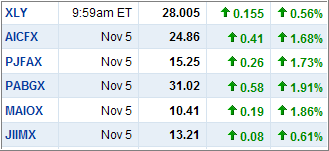 While ETFS have many advantages over mutual funds, they have not been around long enough to address all issues that might affect their NAVs as Seeking Alpha reports in “Bond ETFs Suffer from Pricing Discrepancies:”
While ETFS have many advantages over mutual funds, they have not been around long enough to address all issues that might affect their NAVs as Seeking Alpha reports in “Bond ETFs Suffer from Pricing Discrepancies:”
Exchange traded funds (ETFs) have many of the built-in advantages that mutual funds have, but there are also differences. In my view, the biggest difference is not the fact that ETFs trade throughout the day or even how ETF pricing works, but rather that ETFs have a very short operating history.
We use both mutual funds and ETFs so I am not at all negative about exchange traded funds, but I am aware that there will be growing pains as the ETF industry matures.
In this piece from the Wall Street Journal [registration may be required], we see problems arising in bond ETFs. Namely, that it is hard to price some of the underlying bonds in the various ETF portfolios accurately. Or, it may be difficult for a given ETF to replicate a bond index exactly because the index may hold some bonds that are not traded frequently.
…
…Share prices of many bond ETFs are drifting far from the value of their underlying holdings, which can create big trading costs for investors. Some of the funds are straying from their benchmarks, meaning investors aren’t getting the returns they expected.
…ETFs, typically cheap, straightforward products designed to act like index funds, generally track the performance of a benchmark for stocks, bonds or commodities. But they differ from traditional mutual funds because they trade throughout the day on an exchange.
Keeping ETF returns in line with the indexes has proven to be tough in the murky bond market…
…State Street Corp.’s SPDR Barclays Capital High Yield Bond ETF (JNK) fell nearly 1% in the 12 months ending Aug. 31, even while its benchmark gained 6%…
…The iShares iBoxx $ High Yield Corporate Bond ETF (HYG), for example, traded at a 7% premium at one point in April, and traded within 0.5% of its NAV on only five days in the third quarter…
Such wide gaps aren’t generally supposed to appear in ETFs. Big investors can typically buy up the fund’s underlying holdings and swap them for ETF shares, arbitraging away any significant gaps between the ETF share price and NAV.
But bonds can be so tough to trade that large investors become reluctant to perform this function for fixed-income ETFs. Even when they do make the trades, they incur big trading costs that get factored into the price of the ETF shares…
…
Bond ETFs set the NAV based on estimates of the prices they would get if they sold their holdings. Meanwhile, most bond ETFs are bringing in new money now, so the dealers responsible for creating ETF shares need to constantly buy new securities. That takes place at the higher “offer” side. To compensate, dealers will price the ETF shares higher than NAV, resulting in the bias toward a premium.
If it’s a matter of buying and selling at inflated prices, it’s a wash. But sometimes, investors who bought at a premium end up selling at a discount. “If everybody is selling, it’s also a time where there may not be much liquidity in the bond market, and…funds will be trading at NAV or at a discount to NAV,” says Kenneth Volpert, a principal at Vanguard Group.
In fact, when investors fled corporate bonds last fall, many bond ETFs traded at meaningful discounts. This year, some $25 billion has gone into bond ETFs, a good portion of which is chasing big returns in high-yield bonds, which are notoriously difficult to trade in tough times. How would ETF prices handle that money being pulled out in a flash?…
So far, the discrepancies between a given ETF’s share price and its net asset value (NAV) seem to be manageable. As anyone who has ever purchased bonds knows, bond traders do a good job of exacting their pound of flesh, particularly for thinly-traded securities. So, the cost of putting together a portfolio that matches a given index would be very difficult and costly.
This last point is a good one though. If all the investors in a given ETF want to get out at the same time, raising cash may be an issue. And, if a given ETF has to raise a lot of cash quickly, it will probably get dinged a bit on those securities that it sells.
[Emphasis added]
While there is no good way to deal with this pricing issue, you might want to consider no load mutual funds if your mode of operation is to generate income.
However, in a zero interest rate environment, the risk in bonds, bond ETFs and bond mutual funds is clearly to the downside, especially if inflation rears its ugly head somewhere down the line.
While there is no perfect solution to deal with this issue, I would never hold any of these funds/ETFs without the use of a trailing sell stop.
When the tide turns and interest rates rise, you want to be one of the first heading for the exit doors before they become too crowded. A trailing sell stop may just be the vehicle to get you there before the masses wake up and follow suit.
 The use of sell stops and re-investing monies you have been stopped out of as the market resumes its upward trend, has been the hot topic of the past few weeks. Reader Paul had this to add:
The use of sell stops and re-investing monies you have been stopped out of as the market resumes its upward trend, has been the hot topic of the past few weeks. Reader Paul had this to add:





